Study of the Circular Flat Spiral Coil Structure Effect on Wireless Power Transfer System Performance
Abstract
:1. Introduction
2. Theoretical Analysis
2.1. Two-Coil WPT System Circuit Model
2.2. Circular Flat Spiral Coil Model
3. Impacts of Coil Structure on the WPT System Performance
3.1. Tightly-Wound: Effects of Outer Radius and Coil Turns
3.2. Tightly-Wound: Effects of Inner Radius and Coil Turns
3.3. Loosely-Wound: Effects of Channel Width and Coil Turns
3.4. Loosely-Wound: Effects of Channel Width and Inner Radius
4. Comparison and Discussion
5. Conclusions
Author Contributions
Funding
Conflicts of Interest
References
- Covic, G.A.; Elliott, G.; Stielau, O.H.; Green, R.M.; Boys, J.T. The design of a contact-less energy transfer system for a people mover system. In Proceedings of the PowerCon 2000, International Conference on Power System Technology, Perth, WA, Australia, 4–7 December 2000. [Google Scholar]
- Mecke, R.; Rathge, C. High frequency resonant inverter for contactless energy transmission over large air gap. In Proceedings of the 2004 IEEE 35th Annual Power Electronics Specialists Conference, Aachen, Germany, 20–25 June 2004. [Google Scholar]
- Liu, X.; Hui, S.Y.R. Optimal design of a hybrid winding structure for planar contactless battery charging platform. IEEE Trans. Power Electron. 2008, 23, 455–463. [Google Scholar]
- Li, Y.; Mai, R.; Lin, T.; Sun, H.; He, Z. A novel WPT system based on dual transmitters and dual receivers for high power applications: Analysis, design and implementation. Energies 2017, 10, 174. [Google Scholar] [CrossRef]
- Budhia, M.; Boys, J.T.; Covic, G.A.; Huang, C.Y. Development of a single-sided flux magnetic coupler for electric vehicle IPT charging systems. IEEE Trans. Ind. Electron. 2013, 60, 318–328. [Google Scholar] [CrossRef]
- Zaheer, A.; Hao, H.; Covic, G.A.; Kacprzak, D. Investigation of multiple decoupled coil primary pad topologies in lumped IPT systems for interoperable electric vehicle charging. IEEE Trans. Power Electron. 2015, 30, 1937–1955. [Google Scholar] [CrossRef]
- Bosshard, R.; Muhlethaler, J.; Kolar, J.W.; Stevanovic, I. The η-α-Pareto front of inductive power transfer coils. In Proceedings of the 38th Annual Conference on IEEE Industrial Electronics Society, Montreal, QC, Canada, 25–28 October 2002; pp. 4270–4277. [Google Scholar]
- Fernandez, C.; Garcia, O.; Prieto, R.; Cobos, J.A.; Gabriels, S.; Borght, G. Van Der Design issues of a core-less transformer for a contact-less napplication. In Proceedings of the Seventeenth Annual IEEE Applied Power Electronics Conference and Exposition, Dallas, TX, USA, 10–14 March 2002. [Google Scholar]
- Lyu, Y.L.; Meng, F.Y.; Yang, G.H.; Che, B.J.; Wu, Q.; Sun, L.; Erni, D.; Li, J.L.W. A Method of Using Nonidentical Resonant Coils for Frequency Splitting Elimination in Wireless Power Transfer. IEEE Trans. Power Electron. 2015, 30, 6097–6107. [Google Scholar] [CrossRef]
- Raju, S.; Wu, R.; Chan, M.; Yue, C.P. Modeling of mutual coupling between planar inductors in wireless power applications. IEEE Trans. Power Electron. 2014, 29, 481–490. [Google Scholar] [CrossRef]
- Mutashar, S.; Hannan, M.A.; Samad, S.A.; Hussain, A. Analysis and optimization of spiral circular inductive coupling link for bio-implanted applications on air and within human tissue. Sensors 2014, 14, 11522–11541. [Google Scholar] [CrossRef] [PubMed]
- Sampath, J.P.K.; Alphones, A.; Kenneth, L.Y.Y.; Vilathgamuwa, D.M. Analysis on normalized distance and scalability in designing wireless power transfer. In Proceedings of the 2015 IEEE PELS Workshop on Emerging Technologies: Wireless Power, Daejeon, Korea, 5–6 June 2015. [Google Scholar]
- Zargham, M.; Gulak, P.G. Maximum achievable efficiency in near-field coupled power-transfer systems. IEEE Trans. Biomed. Circuits Syst. 2012, 6, 228–245. [Google Scholar] [CrossRef] [PubMed]
- Kesler, M. Highly Resonant Wireless Power Transfer: Safe, Efficient, and over Distance. WiTricity Corp. Available online: http://large.stanford.edu/courses/2016/ph240/surakitbovorn1/docs/kesler.pdf (accessed on 19 October 2018).
- Miller, J.; Daga, A. Elements of Wireless Power Transfer Essential to High Power Charging of Heavy Duty Vehicles. IEEE Trans. Transp. Electrif. 2015, 7782, 1. [Google Scholar] [CrossRef]
- Roskopf, A.; Bar, E.; Joffe, C. Influence of inner skin- and proximity effects on conduction in litz wires. IEEE Trans. Power Electron. 2014, 29, 5454–5461. [Google Scholar] [CrossRef]
- Lopez-Villegas, J.M.; Samitier, J.; Cane, C.; Losantos, P.; Bausells, J. Improvement of the quality factor of RF integrated inductors by layout optimization. IEEE Transacations Microw. theory Tech. 2000, 48, 76–83. [Google Scholar] [CrossRef] [Green Version]
- Tseng, V.F.G.; Bedair, S.S.; Lazarus, N. 3D electroplated inductors with thickness variation for improved broadband performance. J. Micromech. Microeng. 2017, 27. [Google Scholar] [CrossRef]
- Boys, J.T.; Elliott, G.A.J.; Covic, G.A. An appropriate magnetic coupling co-efficient for the design and comparison of ICPT pickups. IEEE Trans. Power Electron. 2007, 22, 333–335. [Google Scholar] [CrossRef]
- Miller, J.M.; White, C.P.; Onar, O.C.; Ryan, P.M. Grid side regulation of wireless power charging of plug-in electric vehicles. In Proceedings of the 2012 IEEE Energy Conversion Congress and Exposition, Raleigh, NC, USA, 15–20 September 2012. [Google Scholar]
- Onar, O.C.; Miller, J.M.; Campbell, S.L.; Coomer, C.; White, C.P.; Seiber, L.E. A novel wireless power transfer for in-motion EV/PHEV charging. In Proceedings of the 2013 Twenty-Eighth Annual IEEE Applied Power Electronics Conference and Exposition (APEC), Long Beach, CA, USA, 17–21 March 2013. [Google Scholar]
- Wheeler, H.A. Formulas for the Skin Effect. Proc. IRE 1942, 30, 299–311. [Google Scholar] [CrossRef]
- Chan, H.; Cheng, K.; Sutanto, D. A Simplified Neumann’S Formula for Calculation of Inductance of Spiral Coil. IEEE Conf. Publ. 2000, 475, 18–19. [Google Scholar]
- Atluri, S.; Ghovanloo, M. Design of a wideband power-efficient inductive wireless link for implantable biomedical devices using multiple carriers. In Proceedings of the 2nd International IEEE EMBS Conference on Neural Engineering, Arlington, VA, USA, 16–19 March 2005. [Google Scholar]
- Duong, T.P.; Lee, J.W. A dynamically adaptable impedance-matching system for midrange wireless power transfer with misalignment. Energies 2015, 8, 7593–7617. [Google Scholar] [CrossRef]
- Waffenschmidt, E.; Staring, T. Limitation of inductive power transfer for consumer applications. In Proceedings of the 13th European Conference on Power Electronics and Applications, Barcelona, Spain, 8–10 September 2009. [Google Scholar]
- Senjuti, S. Design and Optimization of Efficient Wireless Power Transfer Links for Implantable Biotelemetry Systems. Available online: https://ir.lib.uwo.ca/etd/1154/ (accessed on 19 October 2018).
- Kim, J.; Park, Y.J. Approximate Closed-Form Formula for Calculating Ohmic Resistance in Coils of Parallel Round Wires with Unequal Pitches. IEEE Trans. Ind. Electron. 2015, 62, 3482–3489. [Google Scholar]
- Queiroz, A.C.M.D. Mutual Inductance and Inductance Calculations by Maxwell’s Method. Available online: https://deanostoybox.com/hot-streamer/TeslaCoils/OtherPapers/Antonio/maxwell.pdf (accessed on 19 October 2018).
- Zierhofer, C.M.; Hochmair, E.S. Geometric approach for coupling enhancement of magnetically coupled coils. IEEE Trans. Biomed. Eng. 1996, 43, 708–714. [Google Scholar] [CrossRef] [PubMed]
- Tortora, G.; Mulana, F.; Ciuti, G.; Dario, P.; Menciassi, A. Inductive-based wireless power recharging system for an innovative endoscopic capsule. Energies 2015, 8, 10315–10334. [Google Scholar] [CrossRef]
- Nagendra, G.R.; Covic, G.A.; Boys, J.T. Determining the Physical Size of Inductive Couplers for IPT EV Systems. Available online: https://ieeexplore.ieee.org/abstract/document/6720158 (accessed on 19 October 2018).
- Liu, X.; Clare, L.; Yuan, X.; Wang, C.; Liu, J. A Design Method for Making an LCC Compensation Two-Coil Wireless Power Transfer System More Energy Efficient Than an SS Counterpart. Energies 2017, 10, 1346. [Google Scholar] [CrossRef]

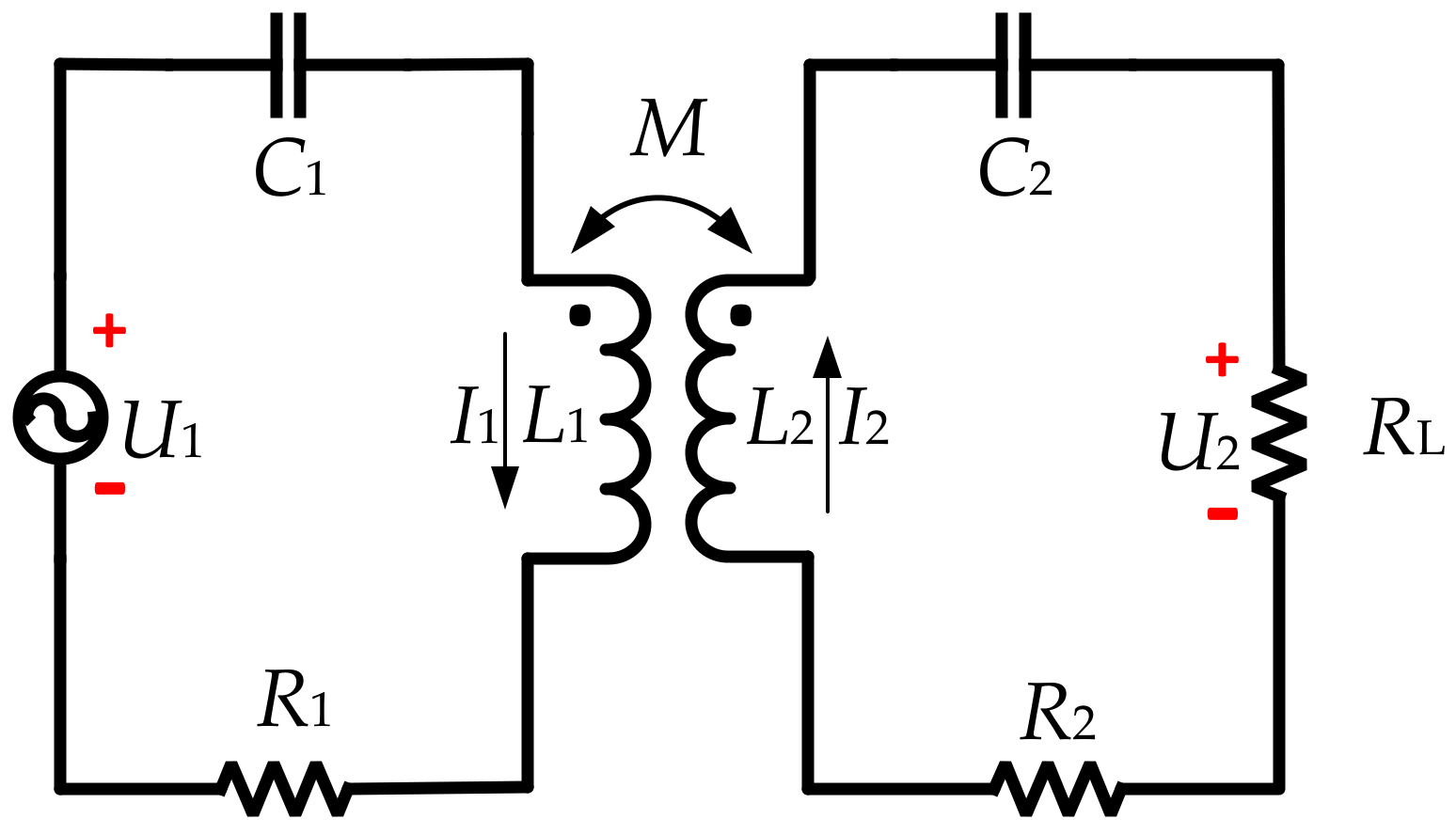

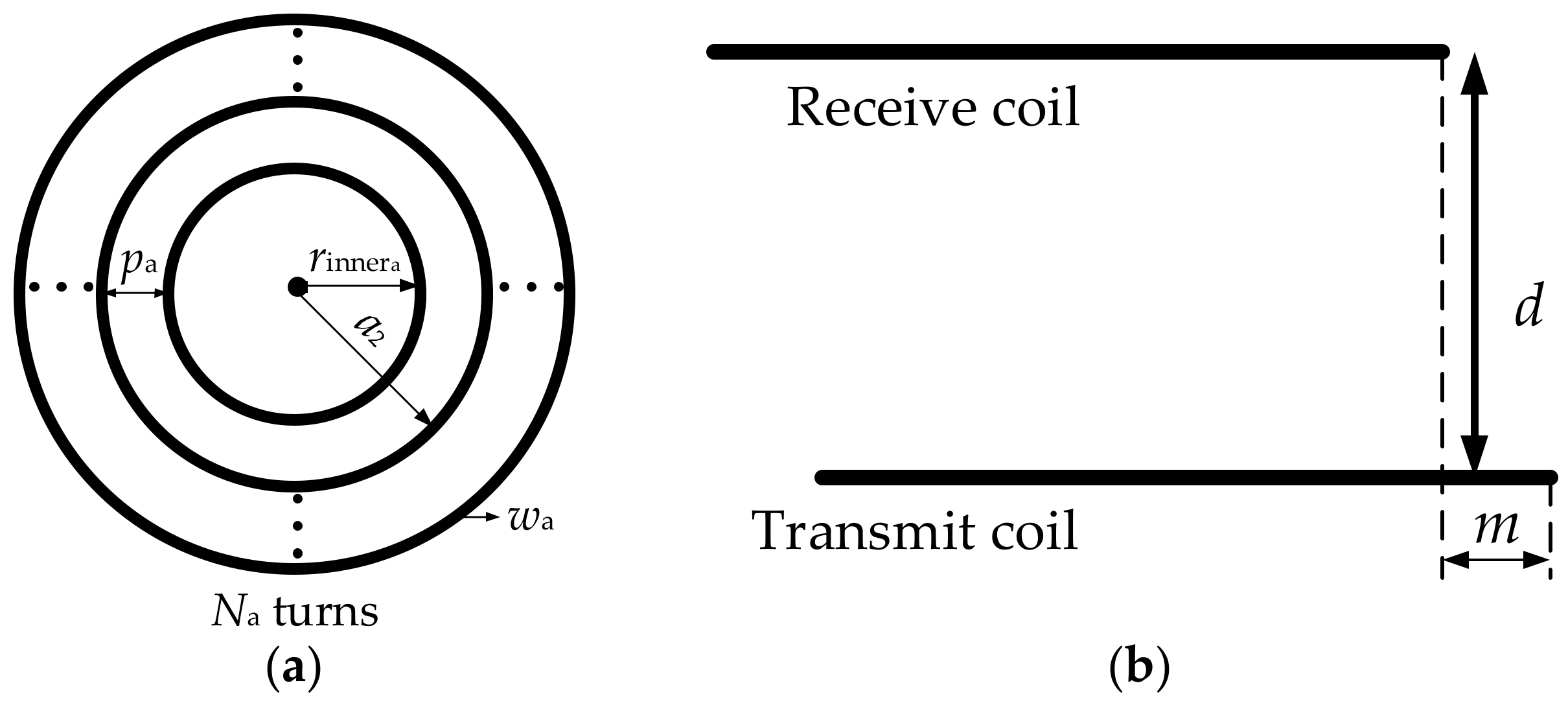

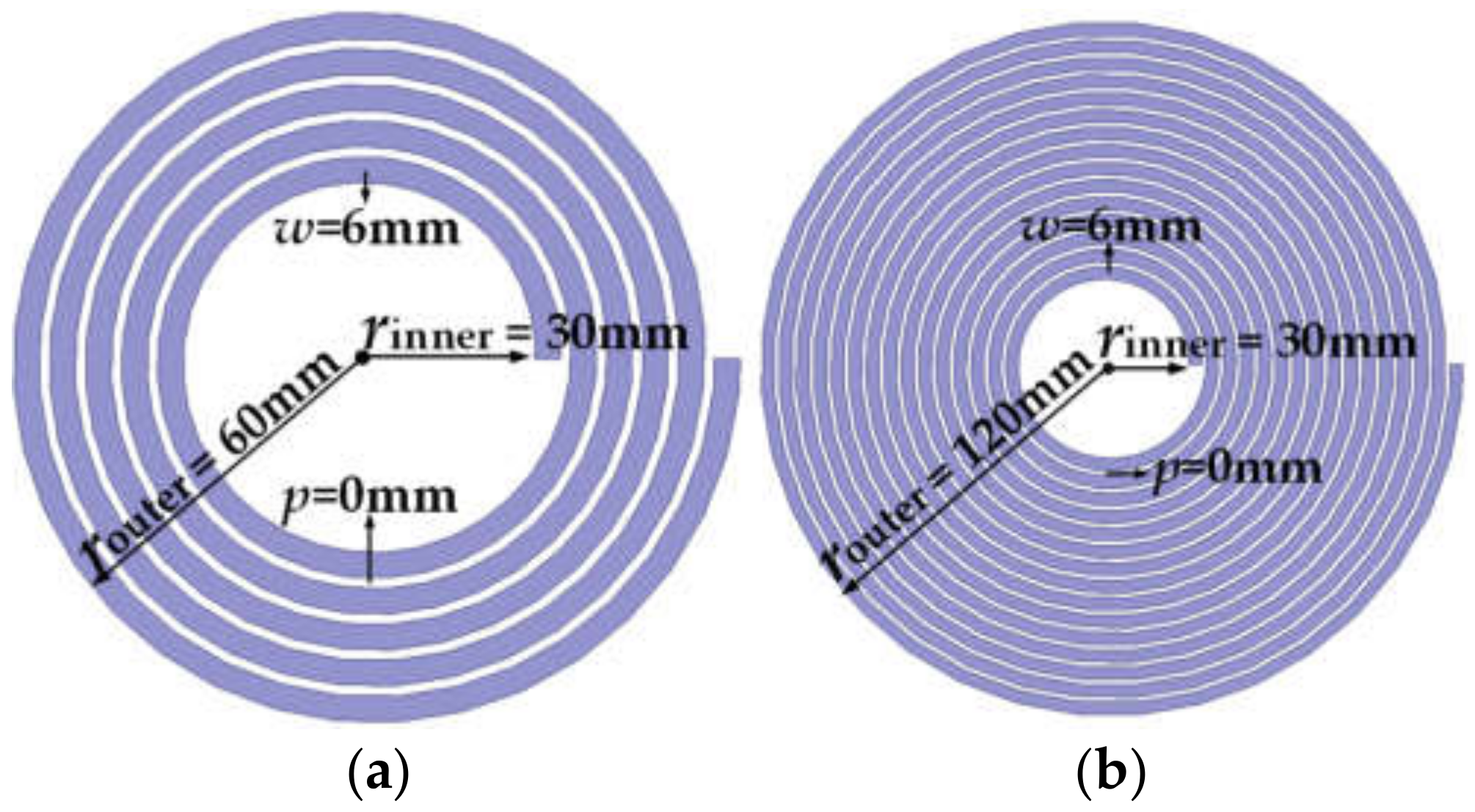

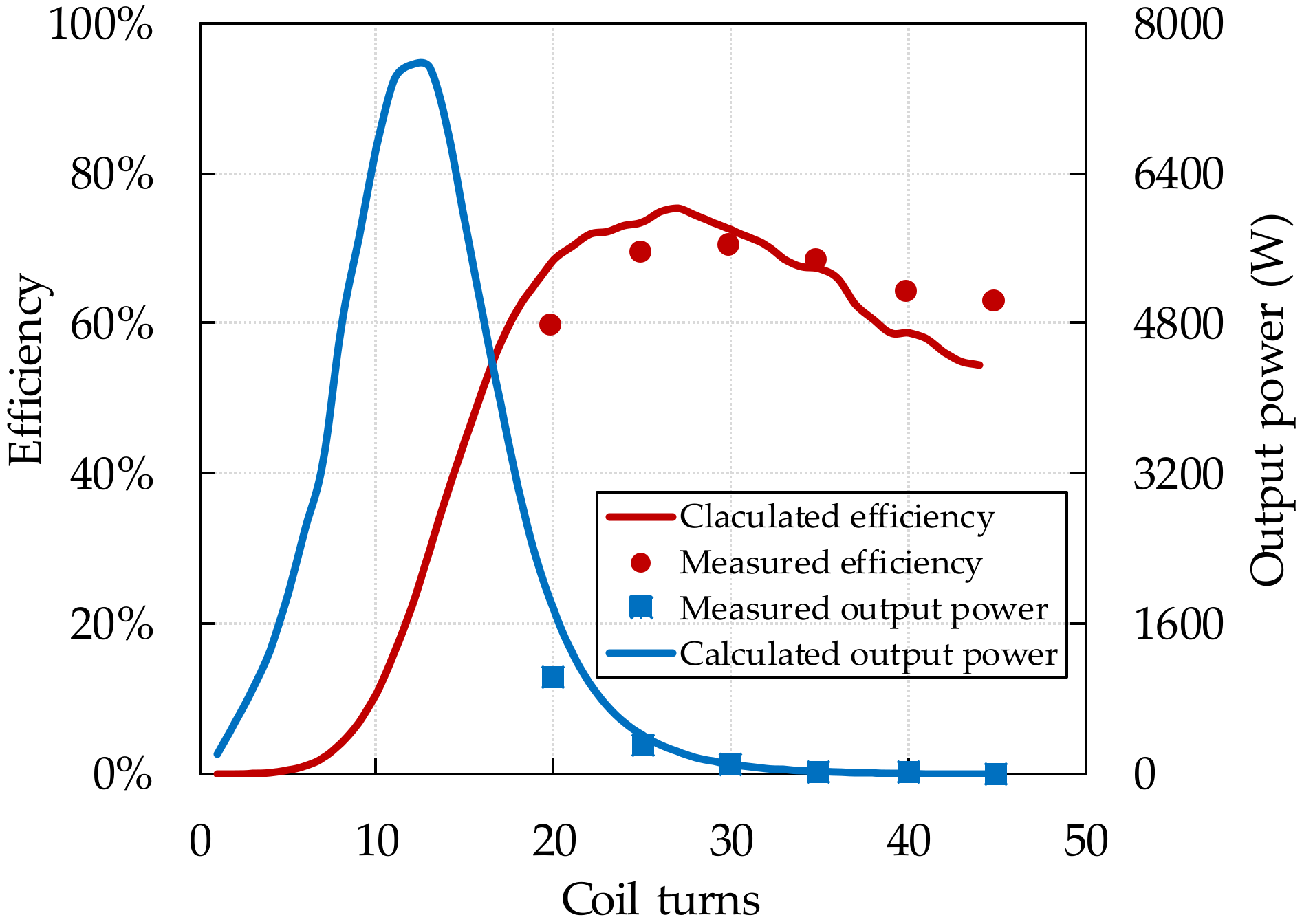
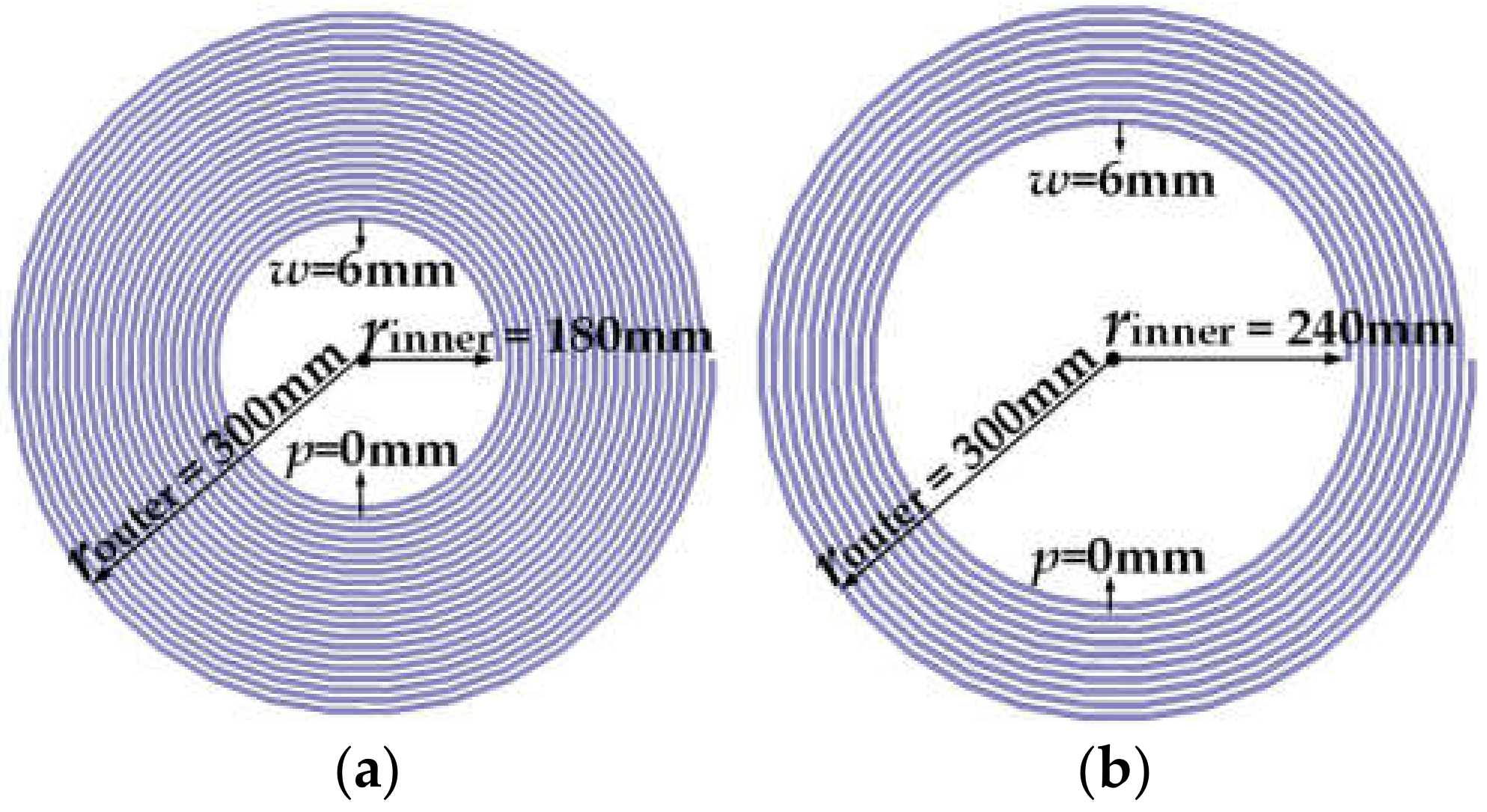

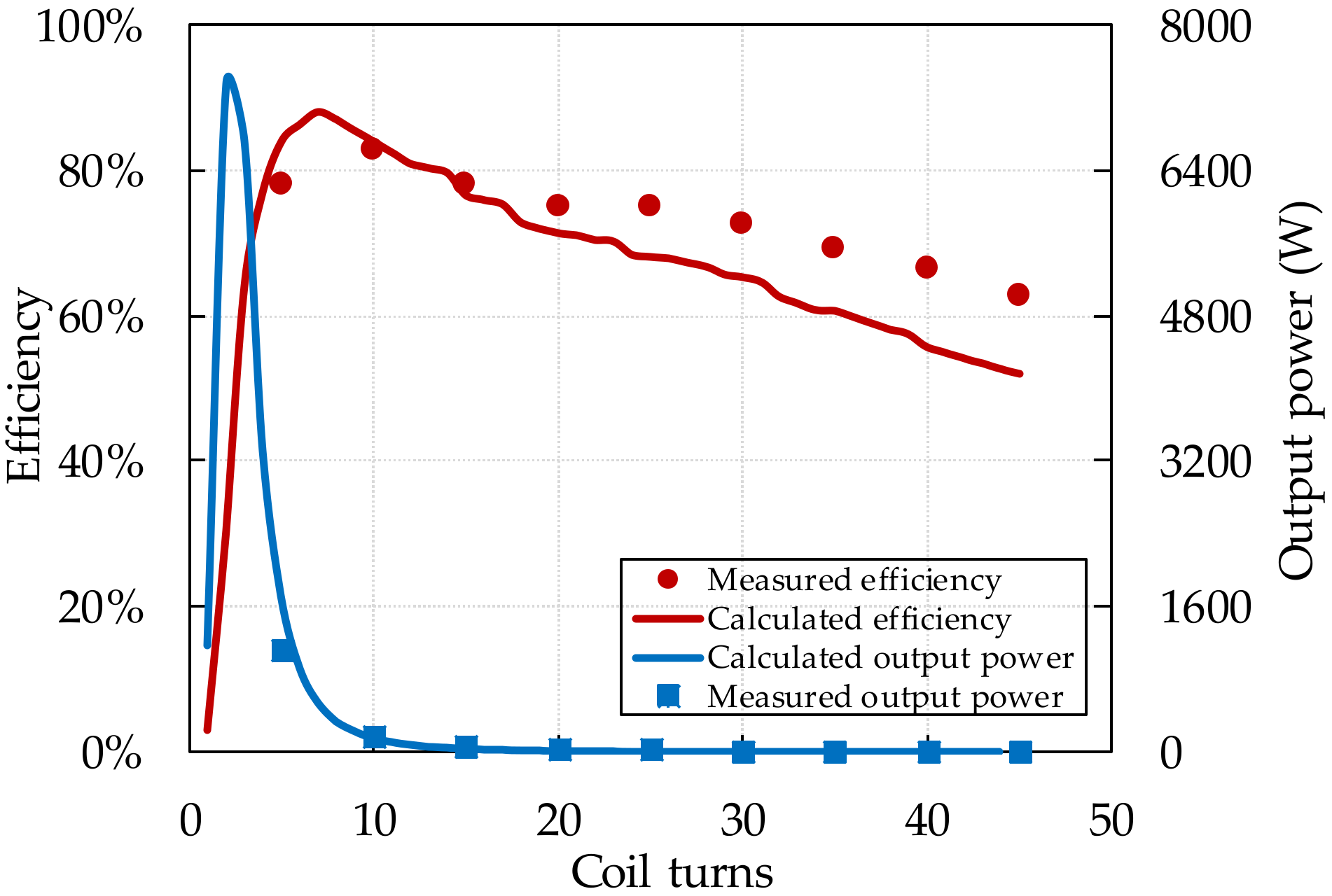
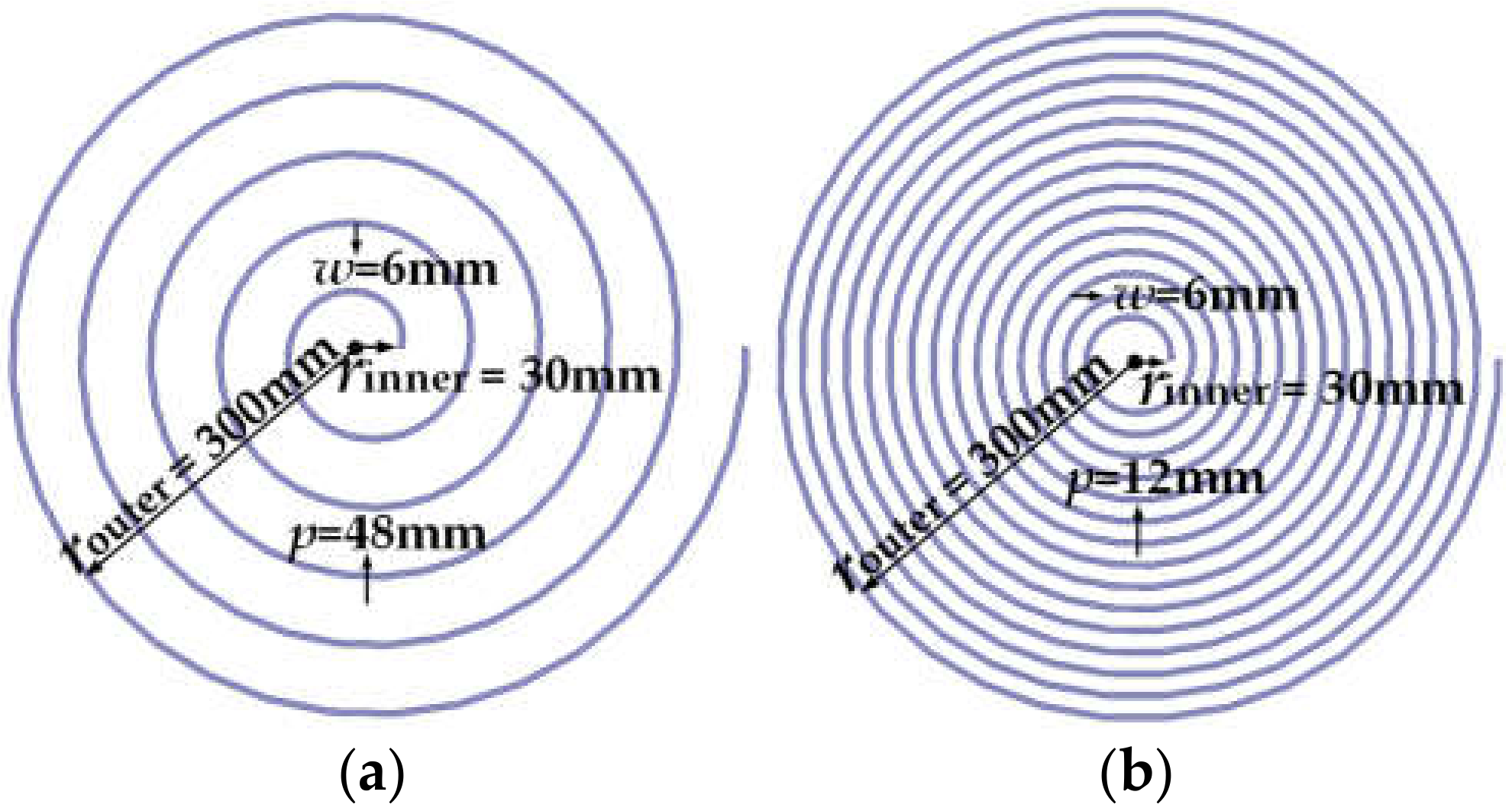

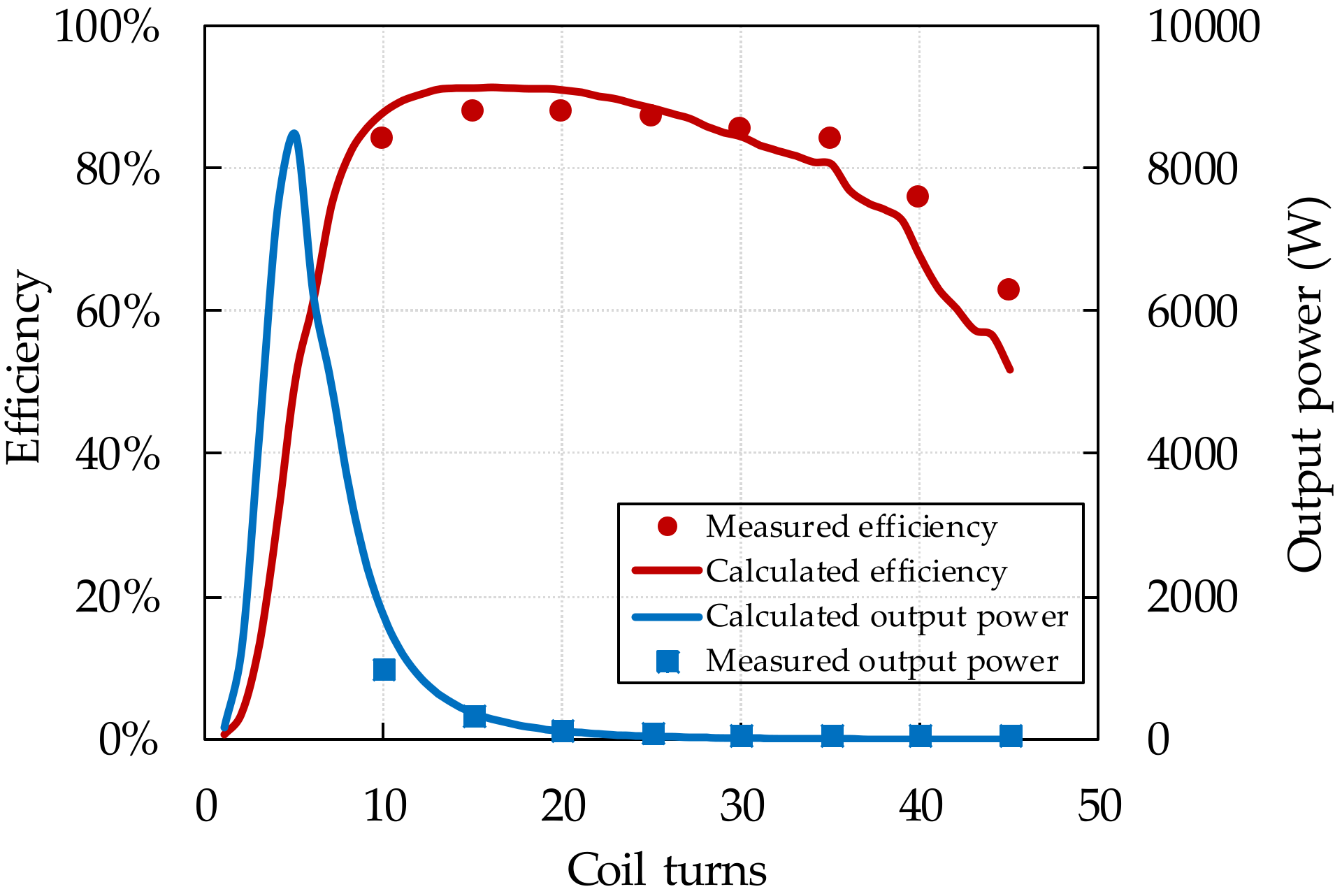
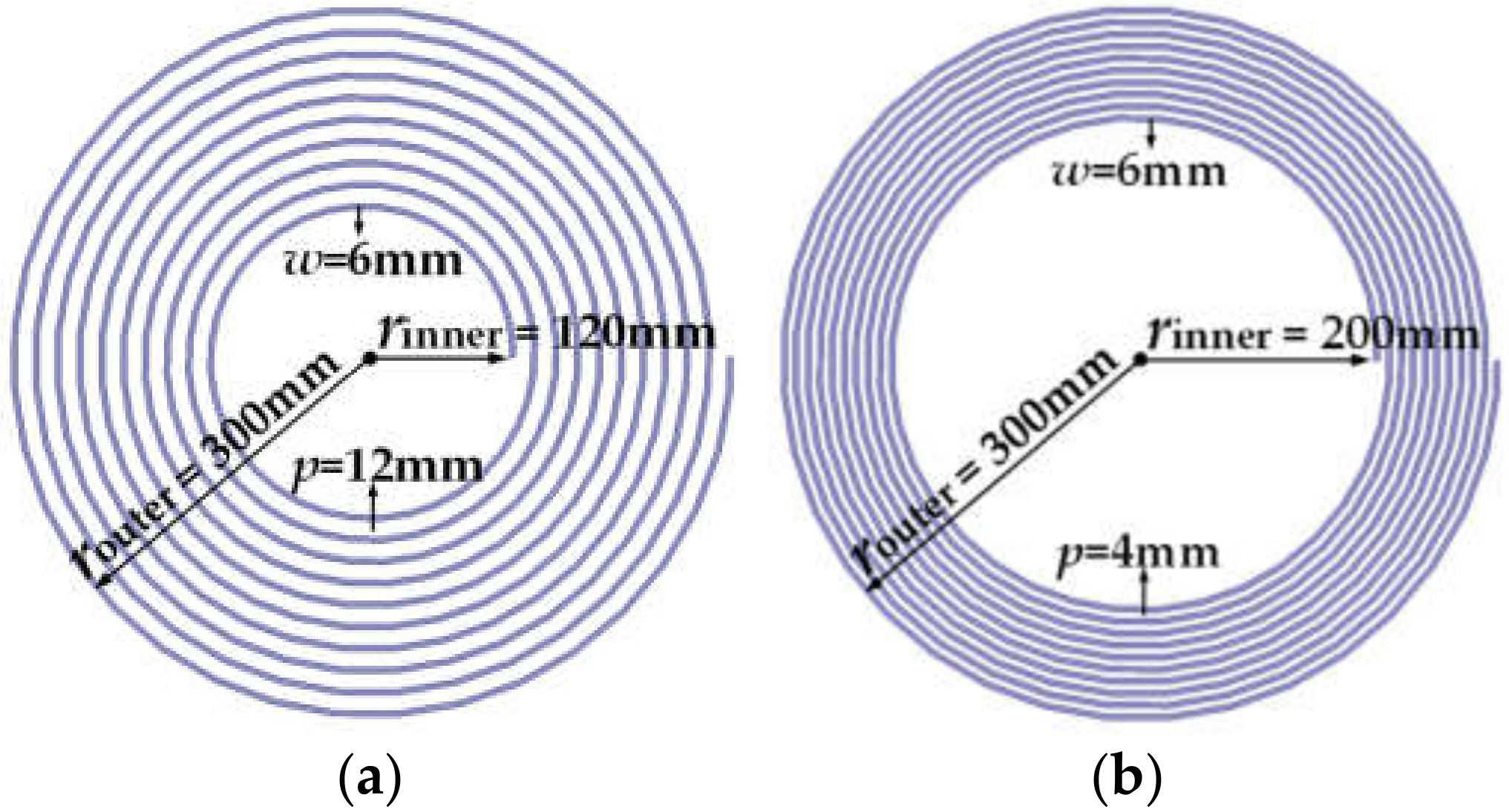
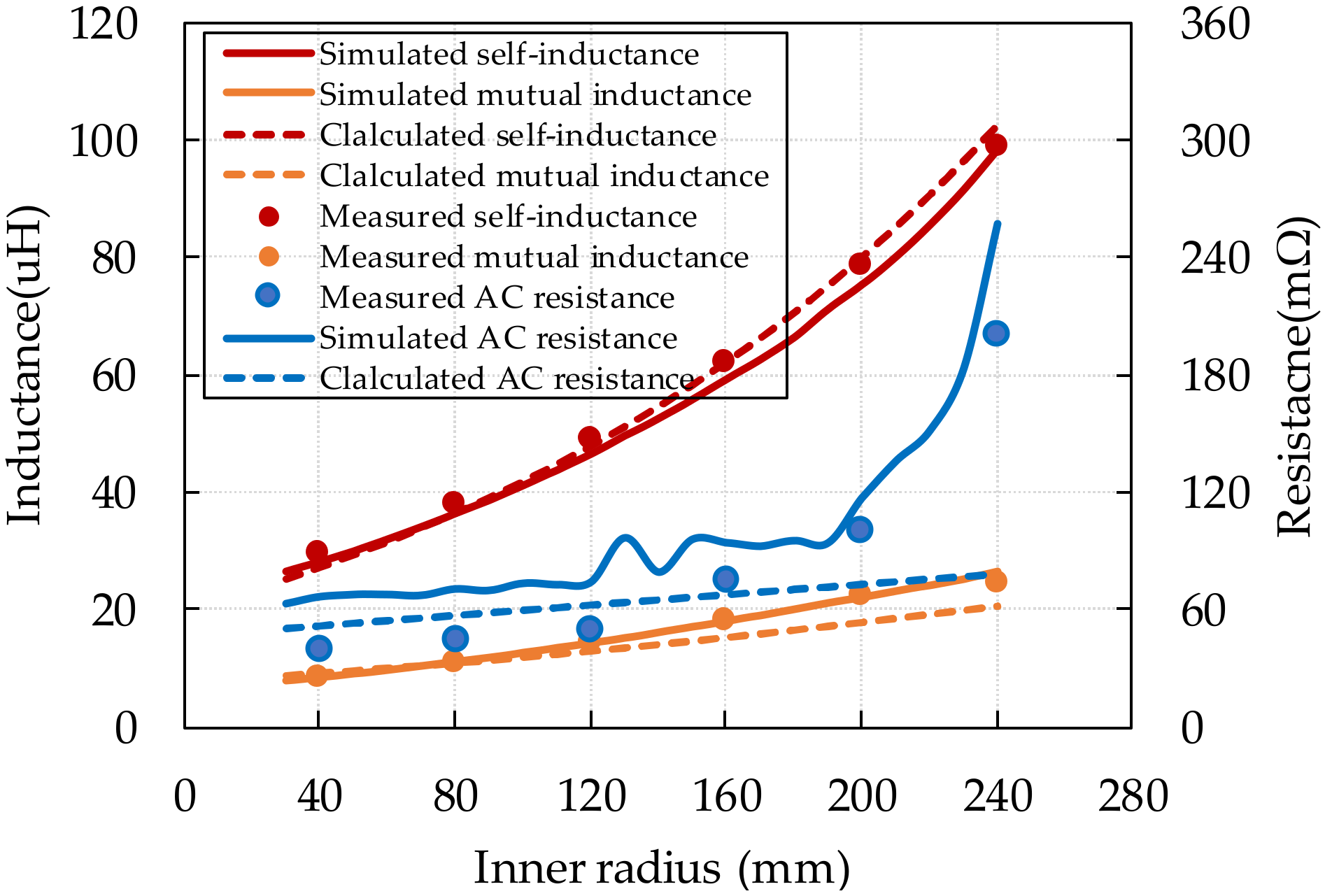
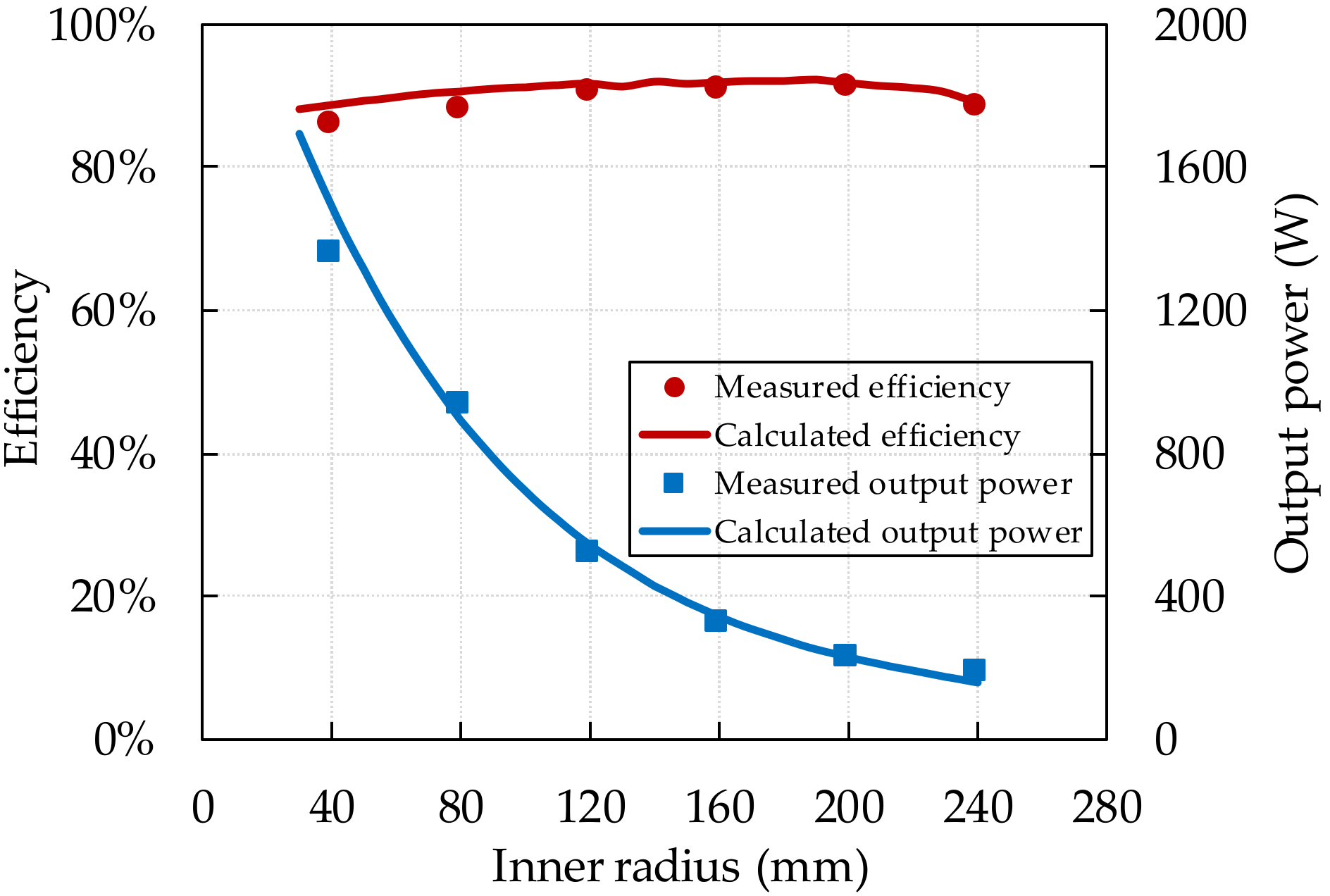

| Design Requirements | Section 3.1 | Section 3.2 | Section 3.3 | Section 3.4 |
|---|---|---|---|---|
| Maximum achievable coil-system efficiency | 75% | 87.94% | 91.4% | 92.32% |
| Maximum achievable output power | 7543 W | 7344 W | 8468 W | 1692 W |
| Most balance design (output power/efficiency) | 3941 W/57% | 3315 W/77% | 6245 W/61% | 1692 W/88% |
© 2018 by the authors. Licensee MDPI, Basel, Switzerland. This article is an open access article distributed under the terms and conditions of the Creative Commons Attribution (CC BY) license (http://creativecommons.org/licenses/by/4.0/).
Share and Cite
Liu, X.; Xia, C.; Yuan, X. Study of the Circular Flat Spiral Coil Structure Effect on Wireless Power Transfer System Performance. Energies 2018, 11, 2875. https://doi.org/10.3390/en11112875
Liu X, Xia C, Yuan X. Study of the Circular Flat Spiral Coil Structure Effect on Wireless Power Transfer System Performance. Energies. 2018; 11(11):2875. https://doi.org/10.3390/en11112875
Chicago/Turabian StyleLiu, Xu, Chenyang Xia, and Xibo Yuan. 2018. "Study of the Circular Flat Spiral Coil Structure Effect on Wireless Power Transfer System Performance" Energies 11, no. 11: 2875. https://doi.org/10.3390/en11112875





